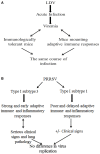Immune Control of PRRS: Lessons to be Learned and Possible Ways Forward
- PMID: 26664910
- PMCID: PMC4668844
- DOI: 10.3389/fvets.2014.00002
Immune Control of PRRS: Lessons to be Learned and Possible Ways Forward
Abstract
Porcine reproductive and respiratory syndrome (PRRS) is an elusive model of host/virus relationship in which disease is determined by virus pathogenicity, pig breed susceptibility and phenotype, microbial infectious pressure, and environmental conditions. The disease can be controlled by farm management programs, which can be supported by vaccination or conditioning of animals to circulating PRRS virus (PRRSV) strains. Yet, PRRS still represents a cause of heavy losses for the pig industry worldwide. Immunological control strategies are often compounded by poor and late development of adaptive immunity in both vaccinated and infected animals. Also, there is evidence that results of field trials can be worse than those of experimental studies in isolation facilities. Neutralizing antibody (NA) was shown to prevent PRRSV infection. Instead, the role of NA and adaptive immunity on the whole in virus clearance after established PRRSV infections is still contentious. Pigs eventually eliminate PRRSV infection, which may be correlated with an "educated," innate immune response, which may also develop following vaccination. In addition to vaccination, an immunomodulation strategy for PRRS can be reasonably advocated in pig "problem" farms, where a substantial control of disease prevalence and disease-related losses is badly needed. This is not at odds with vaccination, which should be preferably restricted to PRRSV-free animals bound for PRRSV-infected farm units. Oral, low-dose, interferon-α treatments proved effective on farm for the control of respiratory and reproductive disease outbreaks, whereas the results were less clear in isolation facilities. Having in mind the crucial interaction between PRRSV and bacterial lipopolysaccharides for occurrence of respiratory disease, the strong control actions of low-dose type I interferons on the inflammatory response observed in vitro and in vivo probably underlie the rapid clinical responses observed in field trials.
Keywords: PRRSV; immunomodulation; interferon-alpha; pig; vaccination.
Figures
References
-
- Pastoret PP. Role of vaccination in animal health. Bull Acad Natl Med (2012) 196:589–90. - PubMed
Publication types
LinkOut - more resources
Full Text Sources
Other Literature Sources




